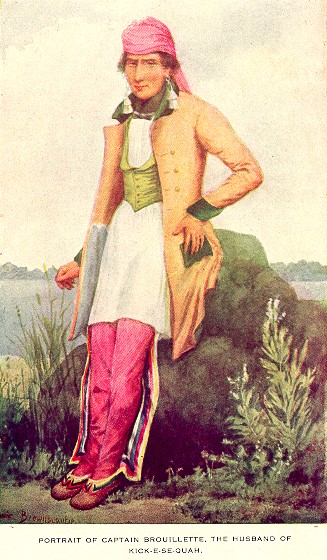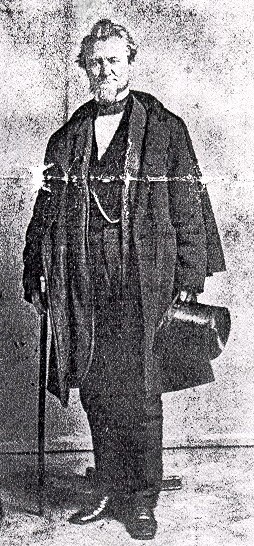 LOCUM
LOCUM
Frances Slocum, Continued
![]()
 LOCUM
LOCUM
Frances Slocum, Continued
![]()
 |
Capt. Jean Baptiste Brouillette - "He wore a fine frock coat of the latest fashion. When the Indian assumes the white man's garb, he always chooses a frock coat. It is an object of beauty to his eye. His 'pesmoker,' or shirt, was white, spotted with small red figures, overhanging very handsome blue leggings, 'winged' with very rich silk ribbons of prismatic hues, exhibiting the squaw's skillful needle work. A handsome red silk sash was thrown gracefully over his left shoulder, and passing over his breast and under the right arm, with clusters of knots, and fringed masses, gave point and style to Brouillette's tall and majestic figure." "Mrs. Phelps also owns a full length painting in oil of Captain Brouillette, husband of Ke-ke-se-qua, painted from a sketch made by Winter in 1837. It represents him clad in a semi-civilized costume of gaudy colors." [Ch. XII, John F. Meginness, "Biography of Frances Slocum, The Lost Sister of Wyoming"] Picture, signed Jennie Brownscombe, from Frances Slocum; The Lost Sister of Wyoming, by Martha Bennett Phelps, 1916. |
 Colonel George W. Ewing [picture from the poster announcing the Slocum family reunion, Peru, Indiana, August 15, 1916] |
In January 1835 a visiting fur
trader, Colonel George
W. Ewing, noticed the whiteness of France's skin, questioned
her (in
the Miami language), and eventually learned her story. Ewing wrote to
the
postmaster at Lancaster, Pa., to learn if there were any Slocum's in
the
vicinity, and requested that it be published in some newspapers. But
his
letter was neglected for two years. It was discovered and published in
the Lancaster Intelligencer in August, 1837. The account was sent to
Joseph
Slocum, a younger brother of Frances, in Wilkes Barre. Joseph's son,
Jonathan
J. Slocum, wrote to George Ewing.
From the letter Geo. W. Ewing, Logansport, Ind., wrote
to Jon. J. Slocum,
Esq., Wilkes Barre, Aug. 26, 1837. "There are perhaps men who
could
have heard her story unmoved; but for me, I could not; and when I
reflected
that there was, perhaps, still lingering on this side of the grave some
brother or sister of that ill-fated woman, to whom such information
would
be deeply interesting, I resolved on the course which I adopted, and
entertained
the fond hope that my letter, if ever it should go before the public,
would
attract the attention of some one interested. In this it seems, at
last,
I have not been disappointed, although I have long since supposed it
had
failed to effect the object for which I wrote it. Like you, I regret
that
it should have been delayed so long, nor can I conceive how any one
should
neglect to publish such a letter." [From Frances
Slocum;
The Lost Sister of Wyoming, by Martha Bennett Phelps, 1916]
|
From the Letter to the Postmaster at Lancaster, Pa., Jan. 20, 1835
"There is now living near this place, an aged white woman, who a few days ago told me, while lodged in the camp one night, that she was taken away from her father's house, on or near the Susquehanna River, when she was very young -- say, from five to eight years old, as she thinks -- by the Delaware Indians, who were then hostile towards the whites. She says her father's name was Slocum; that he was a Quaker, ... She says three Delawares came to the house in the daytime, when all were absent but herself, and perhaps two other children; her father and brothers were absent, working in the field. The Indians carried her off, and she was adopted into a family of Delawares, who raised her and treated her as their own child. They died about forty years ago, somewhere in Ohio. She was married to a Miami, by whom she had four children; two of them are now living -- they are both daughters -- and she lives with them. Her husband is dead; she is old and feeble, and thinks she will not live long."
"Your obedient servant,
"Geo. W. Ewing."
The story of Frances Slocum, Continued
Copyrighted By Ralph W. Robinson,
II.
Return First Frances Slocum Page
Return
Slocum Home Page